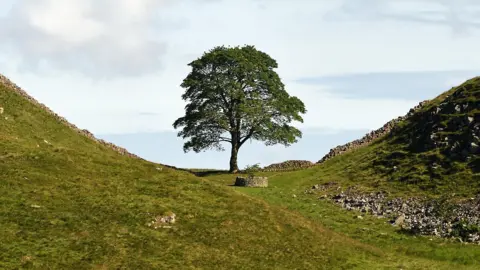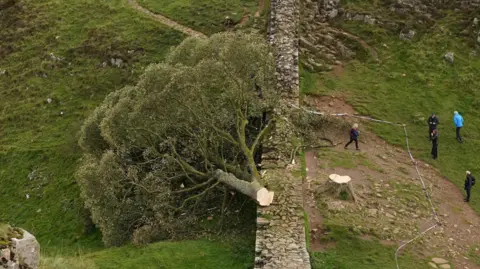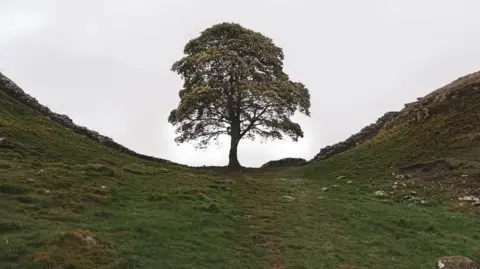Video shows felling of much-loved tree, jury told
Mobile phone footage which prosecutors claim shows the moment the "iconic" Sycamore Gap tree was felled has been shown to jurors.
The tree had stood for more than 100 years in a dip on Hadrian's Wall in Northumberland before it was felled in a "moronic mission" in the early hours of 28 September 2023, Newcastle Crown Court has heard.
Daniel Michael Graham, 39, from Carlisle and Adam Carruthers, 32, from Wigton in Cumbria, each deny two counts of criminal damage relating to the tree and the Roman wall.
Jurors were told the tree was a much-loved feature in Northumberland and had global significance for its position on the former frontier of the Roman empire.
 Nick Lewis
Nick LewisOn the night of 27 September, Mr Carruthers and Mr Graham made a 40-minute drive in the latter's Range Rover from Cumbria to chop the tree down, prosecutors allege.
While one used a chainsaw to fell the tree, the other filmed the act of "mindless" vandalism on Mr Graham's mobile phone, jurors have heard.
The pair then took the wedge cut out of the trunk home as a "trophy" and revelled in the public's outrage over the following days, the court has heard.
 National Trust
National TrustIn statements read to the jury, staff from the National Trust, which had owned the site since the 1940s, and Historic England emphasised the importance of the tree and wall.
Tony Wilmott, a senior archaeologist for Historic England, said Sycamore Gap got its name in the 1980s from the tree in the cleft of the wall.
He said the site was "picturesque" and had become one of the "most prominent and appreciated features" in Northumberland, a symbol of the county with an unmistakeable profile.
The place had become "totemic", he said, adding it was a place of marriage proposals, family visits and even location of ashes for deceased individuals.
"In short, the place is much loved by many thousands of people," Mr Wilmott said, adding its reputation was "spread worldwide" by its inclusion in the 1992 film Robin Hood Prince of Thieves.
 PA Media
PA MediaLee McFarlane, an inspector of ancient monuments for Historic England, said it was "fortunate" the tree was fully in leaf at the time as the canopy bore the brunt of the impact and weight of the fallen tree.
Several stones of the Unesco World Heritage Site wall had been broken though, she added.
Ian Everard of the Forestry Commission said the tree had been deliberately cut using a "hinge-and-wedge" technique so it would fall across the wall, adding it was "unequivocally obvious" where it would end up.
The National Trust said the wall would cost £1,144 to repair while Historic England said the staff hours spent in assessing the damage ran up a bill of more than £6,000.
Jurors also saw body-worn footage from the first police officer at the scene, who arrived at about 11:30 on 28 September and said park rangers were "visibly shocked and upset."
Andrew Pode, the National Trust's general manager for Northumberland coast and Hadrian's Wall, said the tree was "world famous" and had been "unlawfully felled", adding: "No-one had the right or permission to cause damage to the tree."
Mr Pode said the "iconic" tree had been planted in the 1800s by previous landowner John Clayton to be a "feature in the landscape", with the National Trust taking it over on 10 December 1942.
 Alice Whysall-Price
Alice Whysall-PriceJurors were shown a photo taken by Alice Whysall-Price, a holidaymaker out for a walk, who is believed to have been the last person to take a picture of the tree intact, the court heard.
In a statement read to the court, Ms Whysall-Price said she arrived at the tree at about 17:20 on 27 September while walking the length of Hadrian's Wall.
She said the weather was "awful" with wind and rain while a storm was anticipated.
The court also heard Mr Graham's mobile phone and Range Rover were tracked to and from the site and the metadata of the felling video showed it had been filmed at the spot of the tree.
A forensic botanist, Dr Mark Spencer, examined the picture of the wedge of wood in Mr Graham's car, which prosecutors said the pair had taken as a "trophy", and concluded there was "very strong evidence" it had come from the tree with no other possible source identified, the court heard.
The defendants shared screenshots of Facebook posts and media reports in the aftermath, with Mr Graham saying the felling had gone "viral" and "worldwide", the court heard.
The trial continues.
